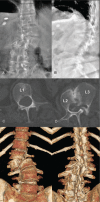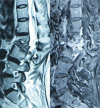Spontaneous rotational dislocation of the lumbar spine in type 1 neurofibromatosis: A case report and literature review
- PMID: 31008966
- PMCID: PMC6494212
- DOI: 10.1097/MD.0000000000015258
Spontaneous rotational dislocation of the lumbar spine in type 1 neurofibromatosis: A case report and literature review
Abstract
Rationale: Scoliosis is the most common form of dystrophic spinal deformities in type 1 neurofibromatosis, whereas a spontaneous rotational dislocation of the lumbar spine is a rare entity. Former researchers had advocated the use of circumferential fusion performed through combined anterior-posterior approaches as the mode of treatment of this situation, but we managed to achieve a solid circumferential fusion equally using posterior approach alone.
Patient concerns: A 51-year-old lady presented with severe back pain and no history of trauma, fever, or loss of weight. On examination, she showed several café-au-lait spots on her body and no neurologic deficit.
Diagnoses: The imageology revealed a rotational dislocation of the L2 to L3. The diagnosis of neurofibroma was confirmed by biopsy.
Interventions: The patient underwent posterior reduction, combined intervertebral-posterolateral fusion, and internal fixation with screws and rods.
Outcomes: The patient was satisfied with the back pain relief after surgery and able to live a normal life at follow-up. The imageology showed a good correction of the deformity with a solid bony fusion.
Lessons: Special attention must be paid to patients who have neurofibromatosis and unexplained back pain for early diagnosis. Early circumferential fusion to reconstruct a stable spine is the key to treatment. Given the result of this case, the prognosis is promising following posterior surgery alone.
Conflict of interest statement
The authors have no conflicts of interest to disclose.
Figures




Similar articles
-
Rotational dislocation of the thoracolumbar spine. Case report and review of the literature.J Neurosurg Spine. 2007 Feb;6(2):161-4. doi: 10.3171/spi.2007.6.2.161. J Neurosurg Spine. 2007. PMID: 17330585 Review.
-
Progressive rotational dislocation in kyphoscoliotic deformities: presentation and treatment.Spine (Phila Pa 1976). 2000 May 1;25(9):1092-7. doi: 10.1097/00007632-200005010-00009. Spine (Phila Pa 1976). 2000. PMID: 10788853
-
Atlantoaxial Dislocation Associated with Type 1 Neurofibromatosis: Case Report and Review of the Literature.World Neurosurg. 2020 Nov;143:261-267. doi: 10.1016/j.wneu.2020.07.176. Epub 2020 Aug 1. World Neurosurg. 2020. PMID: 32750509
-
Pediatric cervical kyphosis in the MRI era (1984-2008) with long-term follow up: literature review.Childs Nerv Syst. 2022 Feb;38(2):361-377. doi: 10.1007/s00381-021-05409-z. Epub 2021 Nov 22. Childs Nerv Syst. 2022. PMID: 34806157 Review.
-
A case report of revision occipital-cervical fusion after atlanto-axial instrumentation failure for neurofibromatosis type I.BMC Surg. 2019 Apr 25;19(1):44. doi: 10.1186/s12893-019-0502-z. BMC Surg. 2019. PMID: 31023294 Free PMC article.
Cited by
-
Tumors and infections of the growing spine.J Child Orthop. 2023 Nov 24;17(6):556-572. doi: 10.1177/18632521231215857. eCollection 2023 Dec. J Child Orthop. 2023. PMID: 38050596 Free PMC article. Review.
-
Biomechanical analysis of spinal range of motion and intervertebral disc loadings in normal and adolescent idiopathic scoliosis models.Front Bioeng Biotechnol. 2025 Feb 19;13:1473776. doi: 10.3389/fbioe.2025.1473776. eCollection 2025. Front Bioeng Biotechnol. 2025. PMID: 40046810 Free PMC article.
References
-
- Akbarnia BA, Gabriel KR, Beckman E, et al. Prevalence of scoliosis in neurofibromatosis. Spine (Phila Pa 1976) 1992;17:S244–8. - PubMed
-
- Kim HW, Weinstein SL. Spine update. The management of scoliosis in neurofibromatosis. Spine (Phila Pa 1976) 1997;22:2770–6. - PubMed
-
- Crawford AH. Pitfalls of spinal deformities associated with neurofibromatosis in children. Clin Orthop Relat Res 1989;29–42. - PubMed
-
- Crawford AJ, Bagamery N. Osseous manifestations of neurofibromatosis in childhood. J Pediatr Orthop 1986;6:72–88. - PubMed
Publication types
MeSH terms
LinkOut - more resources
Full Text Sources
Medical
Research Materials

